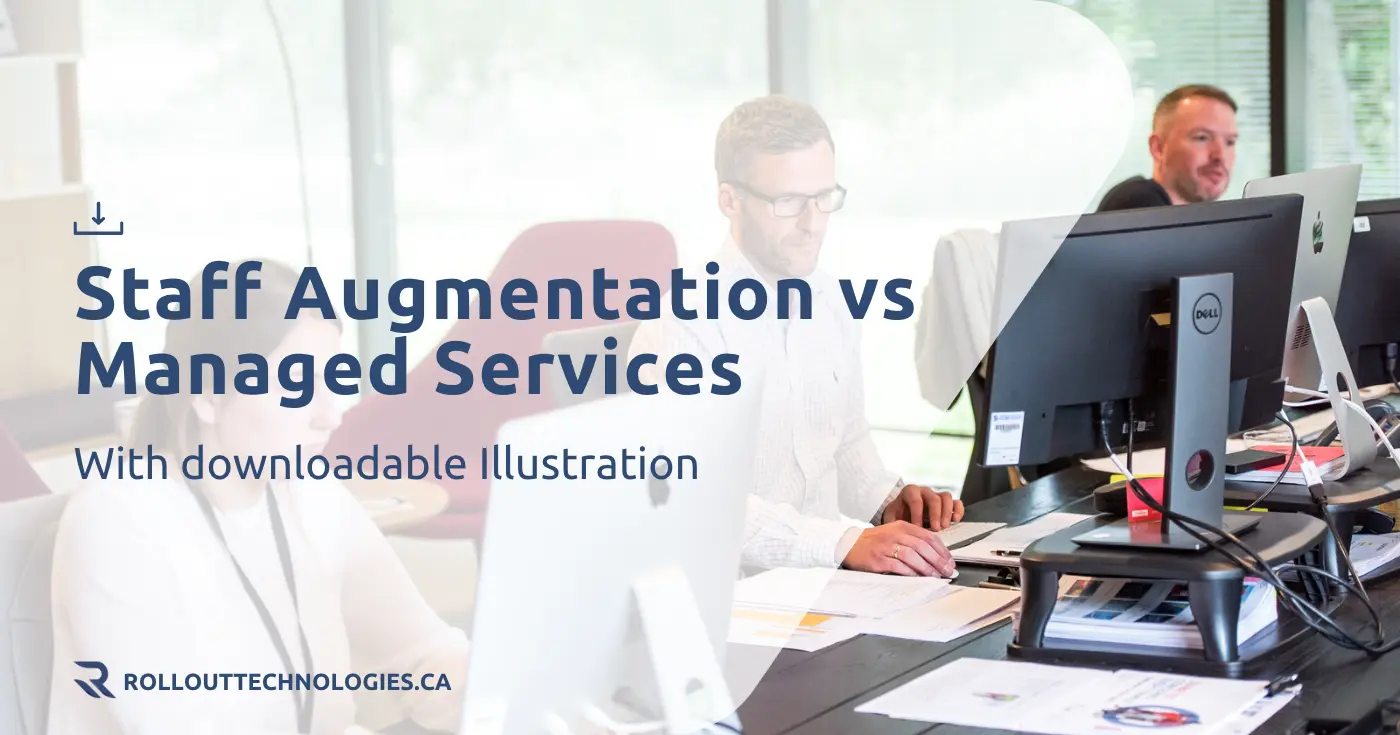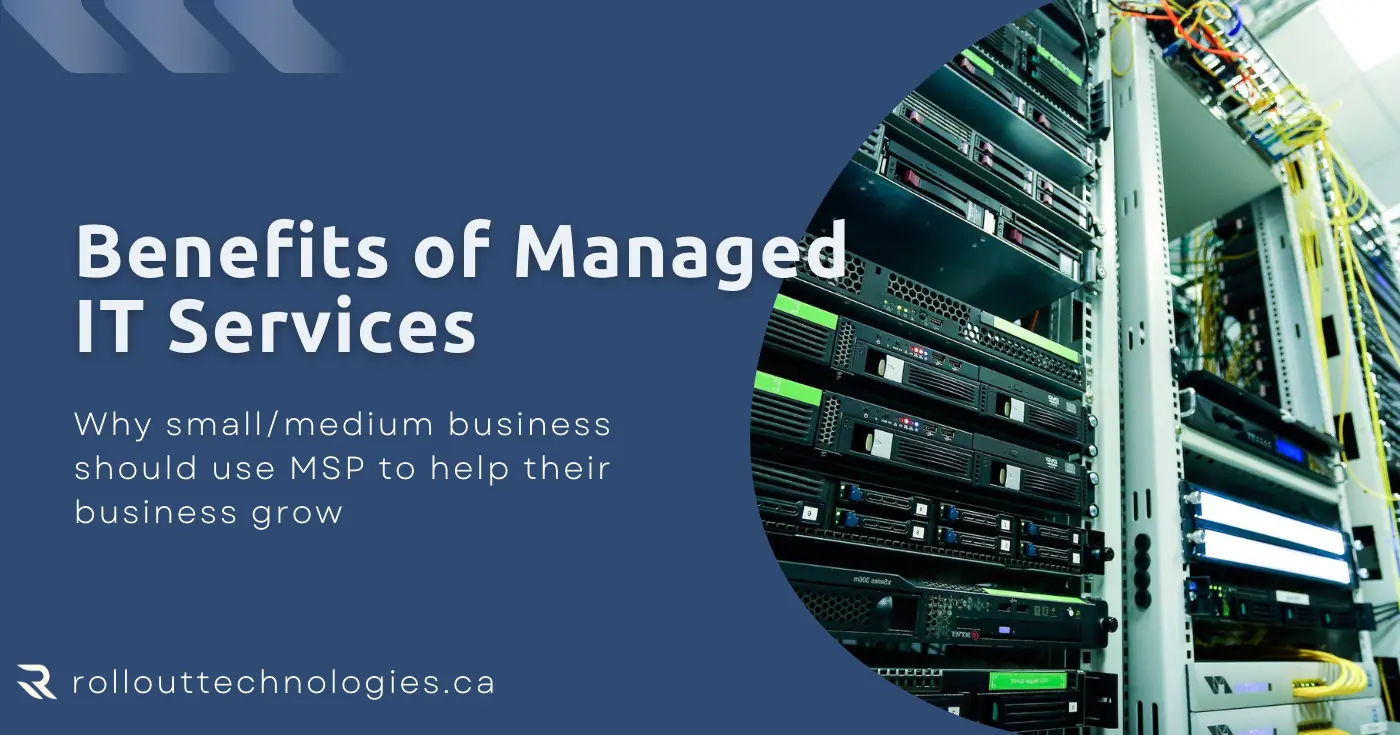Learn the comparison of Staff Augmentation vs Managed Services to determine the best fit for your business needs. Bonus: Download the infographic!
The terms “staff augmentation vs managed services” are frequently used simultaneously, they represent two different ways to address common issues.
In today’s fast-paced business environment, technology plays a crucial role in driving success and growth. Organizations are looking for efficient and cost-effective solutions to manage and maintain their IT infrastructure while ensuring that their technology needs are met in a timely and effective manner.
IT Managed Services, and IT Staff Augmentation are two popular solutions that organizations can leverage to meet their technology needs.
In this blog, we are going to tell you about the difference between the two models in choosing staff augmentation vs managed services, as well as the factors to consider when deciding which option will work best for your IT organization or business.
In the end, you can download the infographic for the difference between the two!
What is Staff Augmentation Service?
Staff augmentation is a business strategy in which organizations bring in additional staff to support or supplement their existing workforce, usually on a temporary or project basis.
The goal of staff augmentation is to address skills gaps, manage increased workloads, and provide access to specialized expertise when needed.
Alternative terms for Staff Augmentation Service include “resource augmentation” or “business augmentation“. These terms emphasize the focus on adding resources or support to the organization, rather than simply hiring new employees.
Types of Staff Augmentation
There are several types of staff augmentation services, including:
Commodity Staff Augmentation
Involves hiring IT personnel with basic skills and knowledge for routine tasks, such as hardware installation, network cable running, data entry, and customer service.
Skill-Based Staff Augmentation
Hiring IT professionals with specific skills and knowledge for projects such as server configuration, IT user support or network administration.
Highly-Skilled Staff Augmentation
Recruiting IT experts with advanced skills and expertise, such as software architecture or cybersecurity, to address specific technology needs or to architect a particular solution.
Each type of staff augmentation has its own unique benefits and can be used depending on an organization’s specific needs and requirements.
Benefits of Staff Augmentation
Access to Specialized Skills
Staff augmentation provides organizations with access to specialized skills and expertise that they may not have in-house. This can be especially helpful when dealing with complex projects or when needing to respond quickly to new challenges.
Flexibility
Hiring flexibility is a key advantage of IT Staff Augmentation. With this approach, organizations can quickly and easily hire additional IT professionals as needed to meet specific project requirements or to cover staff shortages.
This provides organizations with the ability to increase or decrease their IT staff size as needed, depending on their technology needs and budget constraints.
Compared to hiring permanent employees, IT Staff Augmentation offers greater flexibility in terms of the duration of the project, specific skill requirements, and the ability to scale up or down as needed.
This can help organizations reduce their hiring costs, lower their risk of hiring the wrong person, and quickly bring in additional resources as needed.
Additionally, organizations can benefit from the expertise and skills of the augmented IT staff, allowing them to focus on their core business activities while the IT staff handles the technology needs.
Cost-Effectiveness
When deciding between managed services and staff augmentation, cost savings are a top priority for many organizations. And it is understandable as it is possible to find cost-effective contractors without sacrificing the quality of the workforce.
In fact, staff augmentation is often more budget-friendly compared to hiring new employees, as it eliminates the expenses associated with employee benefits, training, and other costs.
Improved Productivity
This can help organizations improve their productivity by freeing up their existing staff to focus on core business activities.
Disadvantages of Staff Augmentation
Limited control
When using staff augmentation, organizations have limited control over the staff being brought in, as they are typically employed by a third-party provider. This can sometimes result in conflicts over responsibilities and decision-making authority.
Quality Risk
The quality of work produced by augmented staff may be inconsistent, especially if the third-party provider does not have the same level of quality control as the organization itself.
Integration Challenges
Augmented staff may struggle to integrate with the existing team, which can lead to friction and decreased productivity.
Monitoring is Difficult
With no formal agreement on the level of service provided, monitoring becomes critical in ensuring that the external staff is delivering on their responsibilities and meeting the needs of the client.
What is Managed Service?
Managed services are a form of outsourcing that involves the transfer of day-to-day management responsibility for an organization’s IT infrastructure and end-user systems to a service provider.
The service provider is responsible for maintaining, updating, and troubleshooting the IT infrastructure and systems, freeing up the organization’s IT staff (if they have one) to focus on more strategic projects.
Benefits of Managed Services
Cost Savings
They can provide significant cost savings compared to in-house IT management, as the service provider is responsible for all expenses related to managing the IT infrastructure and systems.
Access to Expertise
Managed services provide organizations with access to a wide range of expertise. The service provider can use their experience with other clients and provide cost-effective and optimized solutions.
Increased Efficiency
Related to the point above, it help organizations improve their efficiency, as the service provider is often more up-to-date with technology trends and best practices.
Improved Security
They offer comprehensive security solutions that protect against cyber threats and data breaches.
This includes regular software updates, backup and disaster recovery plans, and regular security assessments. These measures help ensure sensitive information is protected and the business is prepared in the event of a security incident.
Additionally, managed services can provide businesses with access to the latest security technologies and expertise, allowing them to stay ahead of emerging threats.
24/7 Monitoring and Maintenance
24/7 Monitoring and Maintenance is a key benefit of managed services, where an IT service provider continually monitors and maintains the systems, networks, and applications of a client.
This means that any potential issues can be detected and resolved before they cause significant problems.
Disadvantages of Managed Services
Dependence on the Service Provider
Organizations can become dependent on their managed services provider, making it difficult to terminate the arrangement if necessary.
Relatively high cost
They can still be expensive, especially if the organization requires a high level of customization.
Lack of Control
When using managed services, organizations have limited control over the IT infrastructure and systems, as they are managed by the service provider. This can sometimes result in conflicts over responsibilities and decision-making authority.
An effective way to resolve issues is through good communication by professional MSPs.
Possible Integration Issues
Integration issues can arise when a managed service provider tries to integrate their services with a client’s existing systems, applications, and networks. This can result in compatibility issues and create additional work to resolve the issue, which can slow down the implementation of the managed services.
An experienced MSP professional can effectively handle the problem through their expertise and communication skills, by presenting a clear picture of the current situation and recommending an optimal solution to implement.
Difference Between Staff Augmentation and Managed Services
Here’s a comparison table between Staff Augmentation and Managed Services:
| STAFF AUGMENTATION | MANAGED SERVICES |
|---|---|
| Involves adding additional personnel to the existing team | Involves outsourcing some or all of a company’s IT operations |
| The hiring company retains control over the work done by augmenting staff | Managed Service provider takes on full responsibility for the operations they manage |
| Short-term or project-based engagement | Long-term engagement with a focus on ongoing support and management |
| Augmenting staff managed by the hiring company | Managed Service provider is responsible for the management and performance of their personnel |
| Costs associated with salary and benefits of augmenting staff | Costs associated with services provided by the service provider, usually a monthly fee |
| The client faces all delivery risks | MSPs take on the risks of operation and transformation |
The main difference between staff augmentation vs managed services is the level of control and responsibility transferred to the third-party provider.
In summary, staff augmentation is more focused on providing additional personnel to support an organization’s existing staff, while managed services are focused on taking over the partial or full management of an organization’s IT infrastructure and systems.
Conclusion
When Staff Augmentation Model is right for you?
Staff augmentation model is right for you when:
- You have specific, short-term project requirements or specialized skills that you need to meet your goals.
- Have a well-established IT infrastructure but need additional resources to manage specific projects.
- Facing a surge in workload or needing additional expertise to meet specific project requirements.
When Managed Services Model is right for You?
Managed services model is right for you when:
- Need a more proactive approach to managing and maintaining your IT infrastructure.
- You want to reduce the burden of managing your IT infrastructure internally.
- To reduce costs and improve efficiency by outsourcing the management of your technology systems to a third-party provider.
- You want to focus on your core business operations and leave the management of your IT infrastructure to the experts.
Additionally, the staff augmentation model is ideal for companies that have specific project needs, require specialized skills and expertise, and have a well-established internal IT infrastructure.
On the other hand, the Managed Services Model is best suited for businesses that require ongoing IT support, have limited internal resources, and need a more comprehensive and cost-effective solution.
Both staff augmentation vs managed services models have their own benefits and limitations, and the choice between them will depend on the specific needs and requirements of the company. Ultimately, the decision should be based on which model will best meet the business’s needs and goals in the most efficient and effective manner.
In conclusion, managed IT services provided by Rollout Technologies can greatly benefit organizations by ensuring the smooth and efficient functioning of their IT systems. Check our managed IT services portfolio!
With their expertise in the field, they can proactively monitor and manage the technology infrastructure, identify and resolve issues before they become major problems, and provide support and guidance to ensure the optimal performance of the technology systems.
This can free up valuable time and resources for organizations, allowing them to focus on their core business operations. By outsourcing managed IT services to Rollout Technologies, organizations can experience improved productivity, enhanced security, and reduced costs.
Download the infographic guide comparing staff augmentation vs managed services, which will provide a visual representation of the key differences and similarities between the two approaches to acquiring IT services.

